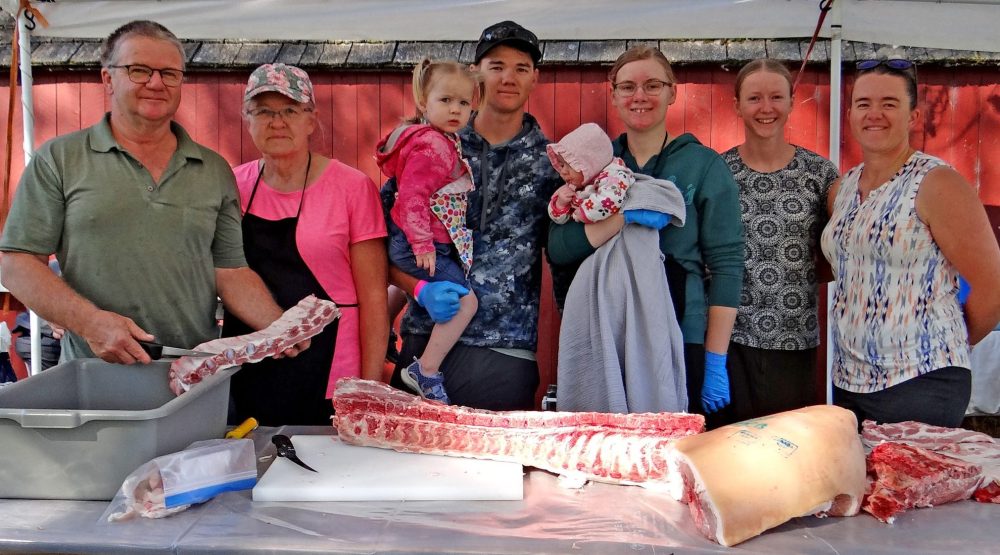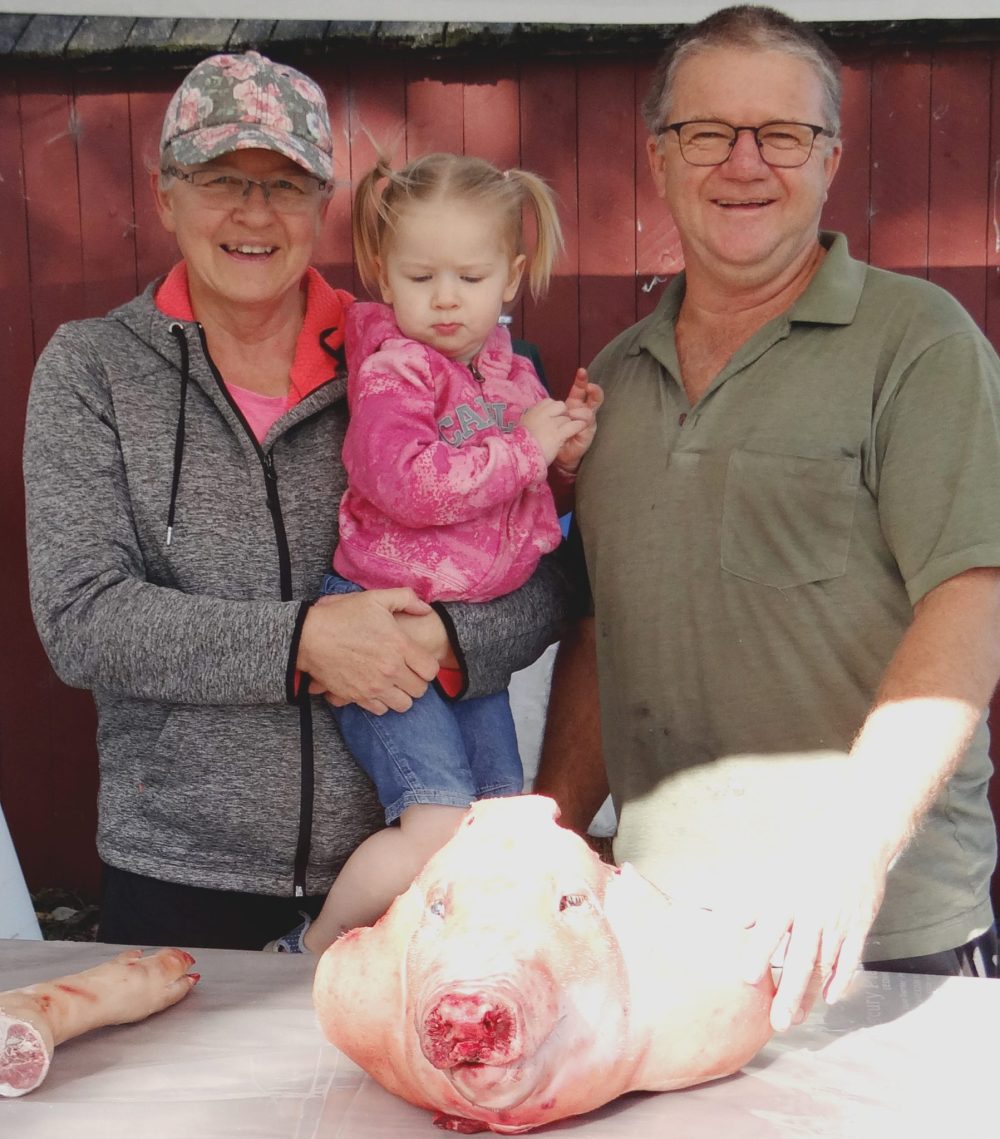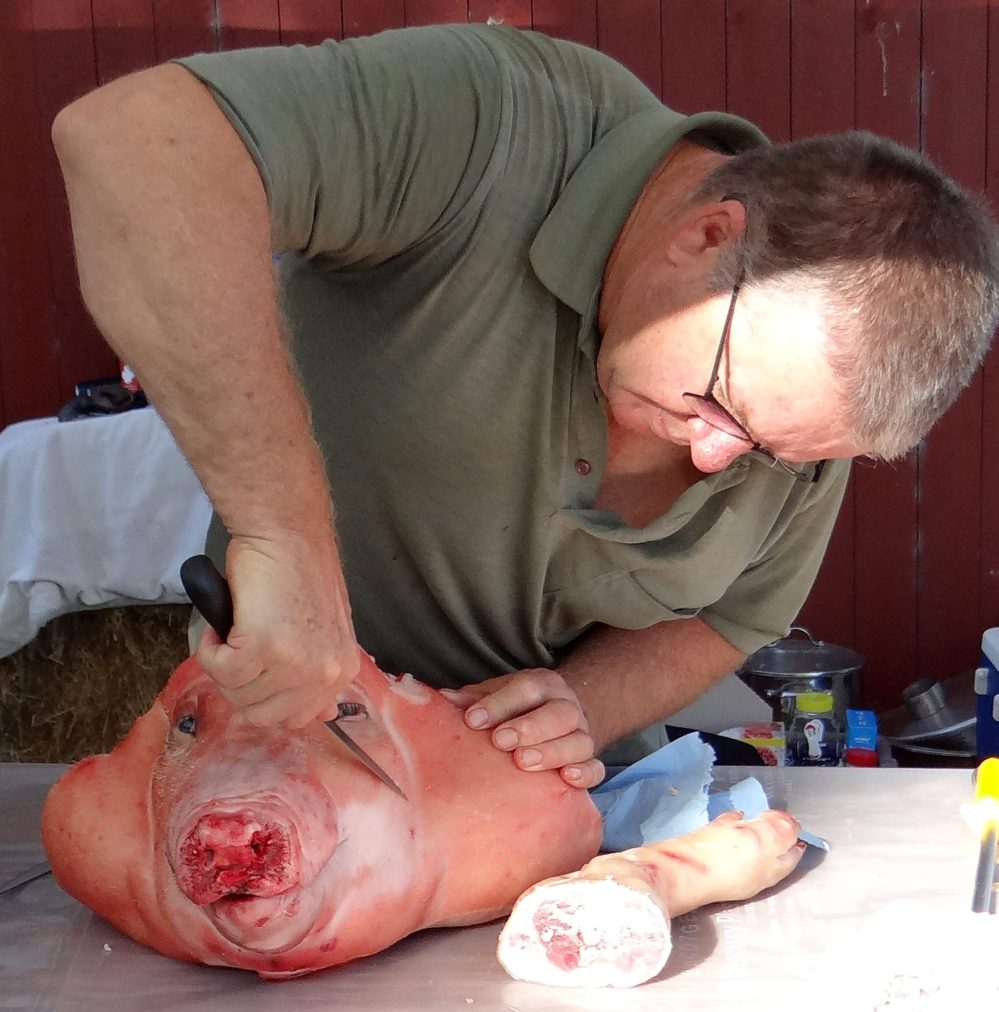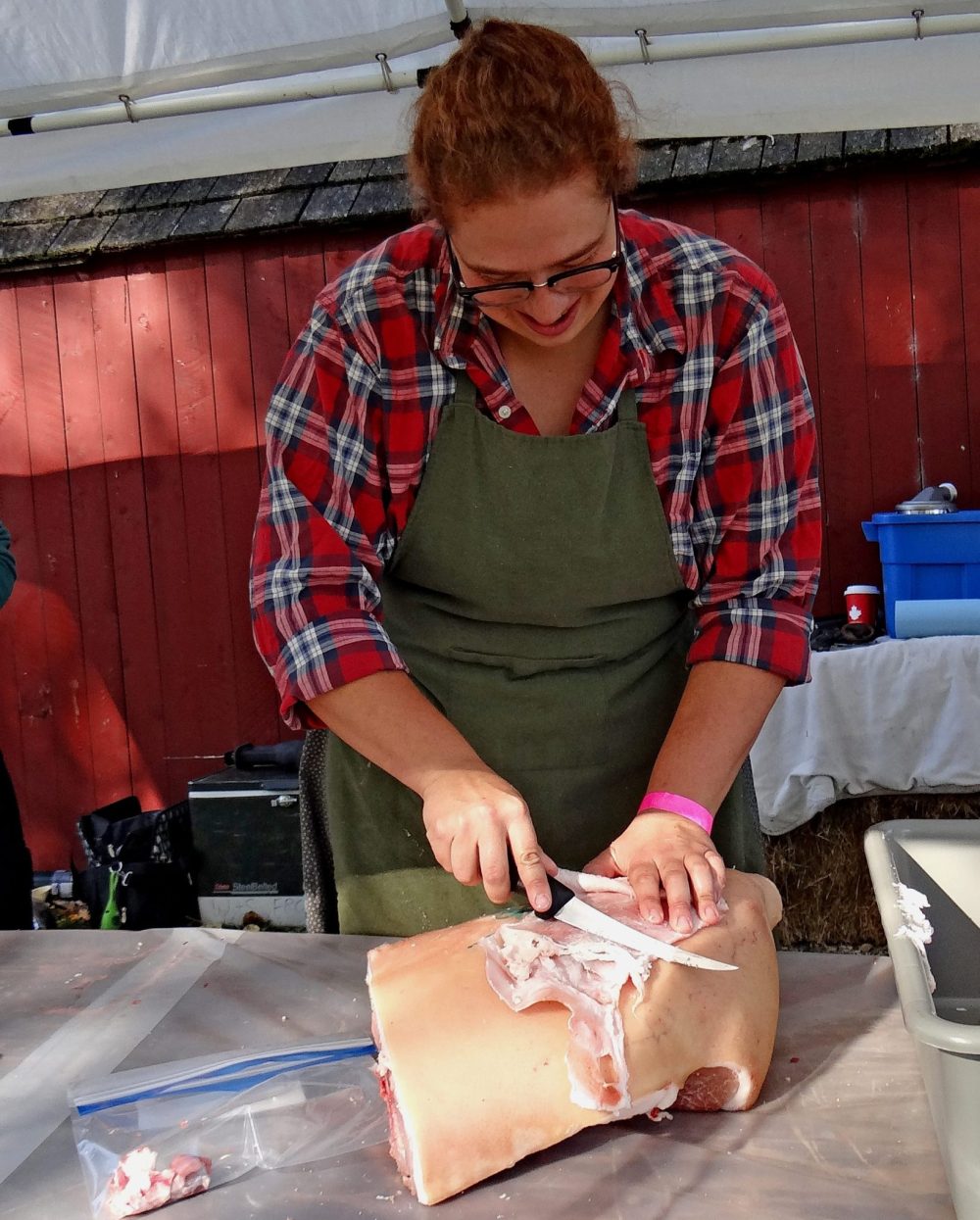‘Fall on the Farm’ more than just one day for Froese family
Advertisement
Hey there, time traveller!
This article was published 07/10/2024 (267 days ago), so information in it may no longer be current.
Members of the Froese family from the Grunthal area have been demonstrating the pioneer skill of hog butchering at the annual Fall on the Farm Day at the Mennonite Heritage Village for much more than a decade.
They cheerfully spend a long day of slicing and cutting, while preparing a whole hog for everything from head cheese, and crackles, to smoked bacon and spare ribs. All the while, members of the family answer questions and show visitors how each part of the pig was used and how things used to be done by pioneers on a farm, that, back then, very much needed to be self-sufficient.
For many older museum visitors, who dropped by the demonstration table, this was the way they remembered it as it used to be, but for the Bill and Sheila Froese family this is very much the way it still is.

Froese Heating and Ventilation has been the family business for 23 years, but the family farm is 140 acres with some cattle, pigs for butchering and chickens, which supply the family with the main ingredient of chicken noodle soup, as well as fresh eggs.
Sheila also has a huge garden and Fall on the Farm Day was a break from her steady fall routine of canning, canning, and more canning. Bill says Sheila has slowed down a bit recently, though, as she used to can 140-150 jars for the pantry shelves and that is now down to probably just over 100.
When asked if all this great food was shared with customers at local farmers’ markets, Bill was quick to say they didn’t need to spend their time that way.
Bill has nine siblings, so there is no shortage of family to help dispose of all they produce on their “hobby farm.”
Family members know that when they are invited to the Froese’s for dinner, they will be well fed, and may even take home a jar or two.
“No farmer’s market for us. We can eat this all ourselves.”
Early in the morning on Fall on the Farm Day, the Froese family was all set up and the cutting process well underway before the arrival of the first visitors.
Using the edge of a sharp knife to scrape the bristles off the head of the demonstration carcass, Bill Froese explains this is the first step in making head cheese and has been his job ever since he was a teenager on the farm.

The parts of the head and the rest of the animal are laid out on the table to explain to young and older visitors alike how every part of the animal was used, “in the old days.”
Bill says his dad’s favorite part of the pig was the snout, but his were the ears and the feet, which were boiled, pickled and then eaten cold.
After a few minutes of scraping bristles by hand, Bill goes to the more modern method and fires up a small torch to burn off the remaining bristles, the easy way. And at the same time, he points out that any visitor expecting to see him turning the handle on an old-fashioned grinder to make sausage in the afternoon, will be disappointed.
The first year at the museum’s fall event, the family did grind the pork by hand, but found that dealing with a 200-pound pig, that was too arduous a task. Now the family brings out their shiny new power grinder from Cabela’s and Mennonite Heritage Village manager Robert Goertzen provides a long cord to plug it in.
The necessity to finish the job in short order also prompts the use of an electric saw to cut through the bigger bones, in preparing different portions of the carcass on the display table.
The pioneers certainly did not have it this easy, but Sheila Froese is quick to note that hard work and healthy eating made for a lengthy life for earlier generations.
Froese’s father, John J. Penner, is 96, still lives in his own home and has his own garden. He used to live in Chortitz, west of the Red River, but has retired to Grunthal, Sheila said.

While she separates the skin from the layer of fat beneath it, Shiela explains the skin will be ground up and used for the making of headcheese. The ground up skin provides the gelatin to hold the headcheese together, she explains.
During the cutting process that creates roasts, hams, spare ribs and bacon, not a single scrap was wasted. A cauldron was heated up to create crackles. Boiling water separated the meat from the lard and the resulting crackles were put in storage to be used as needed. The pioneers ate everything else on a seasonal basis or canned it to save meat that way. Today, it goes into the freezer.
The lard was used for baking or headed for the fryer to make those delicious donuts Mennonites are known for.
A hog producer who visited the table was asked about his favorite part of raising pigs. His reply was that it was when the raising of the pig was done and it was in the oven roasting.
And just like the pioneers, who, out of necessity, used every part of the animal, today’s cooks appreciate the flavour added by pork bones.
Nathan Dueck, who stopped by to chat with the Froeses, said he likes to use pigs’ feet as an ingredient for the base when he makes Ramen. The popular Japanese soup has a hard-to-describe flavour of its own, adding “umami”, (a pleasant savory taste), to the usual salty, sweet, sour or bitter.
And where better place than the museum grounds where a multicultural theme was the order of the day to pick up a cooking tip combining cultures.
Alongside the traditional Russian Mennonite ethnic food in the Livery Barn Restaurant, Fall in the Farm Day visitors had their choice of foods of half a dozen different cultures. Food vendors included Chinese spring rolls, Filipino eats, Paraguayan dishes, Columbian cuisine, Nigerian delicacies, and dishes served up by the Indian Spice Club.

And along with the traditional pioneer demonstrations ranging from threshing to flour milling, a cultures stage featured entertainers representing nine different ethnic groups.
Museum interim executive director Robert Goertzen says this year’s Fall on the Farm program was an effort to make everyone feel welcome at the museum. Mennonite Heritage Village is not just about Mennonites and provides an opportunity to share that culture and history with so many people of other backgrounds, he said.
A popular social event for the early pioneers was the farm auction and the Mennonite Heritage Village took the opportunity to include a small sample again this year.
In the past, a fund-raising auction of donated items was an annual event at the museum, but recently it has been a way to cap off the summer for the museum’s pork producers.
In the spring, a local producer donates three weanlings to the museum and the summer is spent raising the animals to market weight, Goertzen explains.
The pigs spend the summer in a pen, and outdoor shelter with straw, on the museum grounds, getting fed and interacting with visitors to the museum. Sometimes, when they are lucky, the pigs are treated to kitchen scraps and garden waste.
By the end of August, the three pigs weighed close to 200 pounds. They were butchered and two of the carcasses were cut and wrapped at a government inspected facility. The third carcass, as has been the case for about 15 years, was delivered to the museum grounds by the Bill Froese family, who spent the day showing visitors how the animal is cut up, how bacon is prepared, how crackles are made, how sausage is ground up and hams are smoked.

When the Froese family were finished their demonstration, the area was cleaned up and the government inspected cut and wrapped pork from the other two carcasses was auctioned off by Ron Kornelson.
This is good quality pork and people are happy to be generous in their bidding, and the auction usually raises between $1,000 and $1,500 for the museum, Goertzen said.
This is a small version of the farm auction that used to be a social event, where neighbors got together to support the family holding the auction.
The auctioneer creates an atmosphere of friendly competition among bidders, adding a festive note to the occasion.
